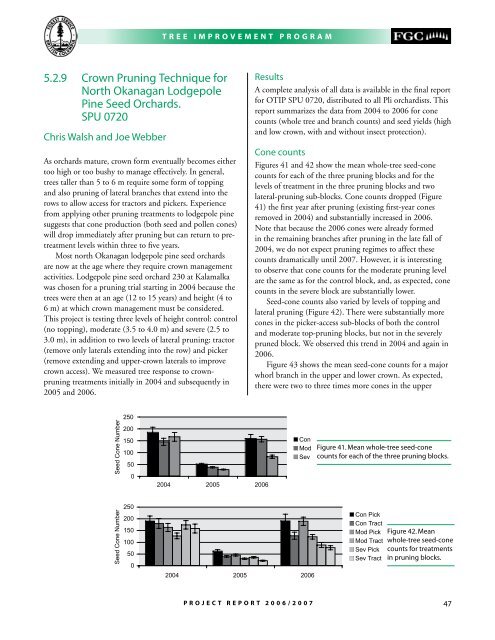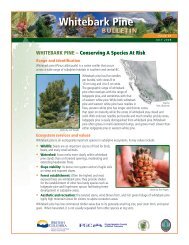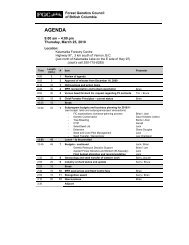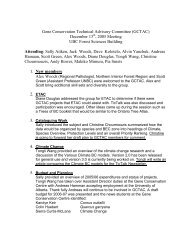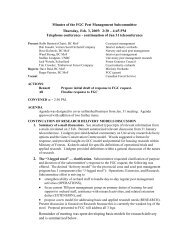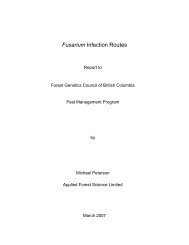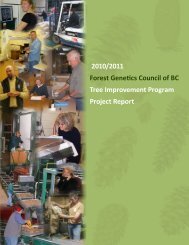Tree Improvement Program Project Report 2006 / 2007
Tree Improvement Program Project Report 2006 / 2007
Tree Improvement Program Project Report 2006 / 2007
Create successful ePaper yourself
Turn your PDF publications into a flip-book with our unique Google optimized e-Paper software.
.2.9 Crown Prun ng Techn que for<br />
North Okanagan Lodgepole<br />
P ne Seed Orchards.<br />
SPU 0720<br />
Chr s Walsh and Joe Webber<br />
As orchards mature, crown form eventually becomes either<br />
too high or too bushy to manage effectively. In general,<br />
trees taller than 5 to 6 m require some form of topping<br />
and also pruning of lateral branches that extend into the<br />
rows to allow access for tractors and pickers. Experience<br />
from applying other pruning treatments to lodgepole pine<br />
suggests that cone production (both seed and pollen cones)<br />
will drop immediately after pruning but can return to pretreatment<br />
levels within three to five years.<br />
Most north Okanagan lodgepole pine seed orchards<br />
are now at the age where they require crown management<br />
activities. Lodgepole pine seed orchard 230 at Kalamalka<br />
was chosen for a pruning trial starting in 2004 because the<br />
trees were then at an age (12 to 15 years) and height (4 to<br />
6 m) at which crown management must be considered.<br />
This project is testing three levels of height control: control<br />
(no topping), moderate (3.5 to 4.0 m) and severe (2.5 to<br />
3.0 m), in addition to two levels of lateral pruning: tractor<br />
(remove only laterals extending into the row) and picker<br />
(remove extending and upper-crown laterals to improve<br />
crown access). We measured tree response to crownpruning<br />
treatments initially in 2004 and subsequently in<br />
2005 and <strong>2006</strong>.<br />
Seed Cone Number<br />
Seed Cone Number<br />
250<br />
200<br />
150<br />
100<br />
50<br />
0<br />
250<br />
200<br />
150<br />
100<br />
50<br />
0<br />
T R E E I M P R O V E M E N T P R O G R A M<br />
2004 2005 <strong>2006</strong><br />
P R O J E C T R E P O R T 2 0 0 6 / 2 0 0 7<br />
Results<br />
A complete analysis of all data is available in the final report<br />
for OTIP SPU 0720, distributed to all Pli orchardists. This<br />
report summarizes the data from 2004 to <strong>2006</strong> for cone<br />
counts (whole tree and branch counts) and seed yields (high<br />
and low crown, with and without insect protection).<br />
Cone counts<br />
Figures 41 and 42 show the mean whole-tree seed-cone<br />
counts for each of the three pruning blocks and for the<br />
levels of treatment in the three pruning blocks and two<br />
lateral-pruning sub-blocks. Cone counts dropped (Figure<br />
41) the first year after pruning (existing first-year cones<br />
removed in 2004) and substantially increased in <strong>2006</strong>.<br />
Note that because the <strong>2006</strong> cones were already formed<br />
in the remaining branches after pruning in the late fall of<br />
2004, we do not expect pruning regimes to affect these<br />
counts dramatically until <strong>2007</strong>. However, it is interesting<br />
to observe that cone counts for the moderate pruning level<br />
are the same as for the control block, and, as expected, cone<br />
counts in the severe block are substantially lower.<br />
Seed-cone counts also varied by levels of topping and<br />
lateral pruning (Figure 42). There were substantially more<br />
cones in the picker-access sub-blocks of both the control<br />
and moderate top-pruning blocks, but not in the severely<br />
pruned block. We observed this trend in 2004 and again in<br />
<strong>2006</strong>.<br />
Figure 43 shows the mean seed-cone counts for a major<br />
whorl branch in the upper and lower crown. As expected,<br />
there were two to three times more cones in the upper<br />
Con<br />
Mod<br />
Sev<br />
2004 2005 <strong>2006</strong><br />
F gure 1. Mean whole-tree seed-cone<br />
counts for each of the three prun ng blocks.<br />
Con Pick<br />
Con Tract<br />
Mod Pick<br />
Mod Tract<br />
Sev Pick<br />
Sev Tract<br />
F gure 2. Mean<br />
whole-tree seed-cone<br />
counts for treatments<br />
n prun ng blocks.<br />
7


